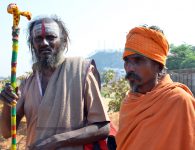Hampi, Pampa, Kishkinda, call it by any name, the surreal beauty of Hampi bewitches even the most jaded cynics. If Shangri-La ever existed, they got its location wrong, every corner in this World Heritage Site is post-card perfect.
History sneaks up on you in the ancient capital of the Vijayanagara Empire and the grandeur of the 500 plus monuments scattered across its hills transport you to a different time altogether.
The city of Vijayanagara was originally surrounded by 7 rows of impregnable fortifications, of these only the inner-most have survived in some form till date. One of the earliest planned cities, the ruins can be roughly divided into the Religious, Civil and Military zones. They say that time moves slower in this arid oasis and that once upon a time diamonds were sold openly on its streets. Like its stories, Hampi needs to be experienced to be believed.
Population: 100,000 (approx) | Languages: Kannada, English, Hindi | Demographics: Predominantly Hindu | Nickname: Vijayanagara
The ruins of Hampi may take weeks to be seen in detail. So vast is the area. And the economy that thrives around it, brings alive the fact that wherever there is tourism in India, there are a variety of great business models in place.
The Palace at Anegondi that Krishna Deva Raya is renovating will use lime plastering on the walls done in a mill exactly as it was done when first built. The mill being used by him now was “discovered” in the garden of the original palace. Virupaksha Temple, Achyutaraya Temple, Vittala Temple, Hazara Rama Temple, and other ruins.
The original double tiered Hampi Bazaar has been cleared by the government of all encroachments and in the bargain has been badly mutilated.
We also met a sadhu who makes grotesque faces and sounds.
The army eating area where scores of soldiers can be fed at the same time is an interesting spot to visit. The “seats” are on both sides of a “table” and both are built of stone, miles in length. The “tables” have indentation of a plantain leaf, one for each person. The main stem of the leaves are joined to a single “water channel” in the middle of the “table”. Each time a round of soldiers is fed, a water stopper far away is pulled open and the channel has water gushing in that rinses all the “plates” on which the soldiers ate. The next group can be called to sit down for a meal. Ingenious methodology. Incredible time and efficiency management.
We also interviewed a Sadhu.





No comments